Prohibition
– Alphonse (Al) Capone
The devastation of European vineyards from 1860-1880 by the root eating insect, Phylloxera, caused international wine production to plummet. In response, American vineyards began planting grapes and making more wine. The first wine growing areas located in California, New York, and Virginia, all had active wineries by the mid-1800s. Ironically, as international demand and interest in wine production increased, the Prohibition movement in America was gaining momentum.
One of many reform movements sweeping through the United States in the latter half of the nineteenth century, Prohibition took aim at the manufacture and sale of alcoholic beverages, which a growing segment of the public had come to view as the evil spirit responsible for all of society’s ills — poverty, lawlessness, addiction, unemployment, domestic abuse, sickness, and more.
Passed in 1917, ratified in 1919, and enacted in 1920, the Eighteenth Amendment, known as the “noble experiment,” banned commercial production and sale of alcohol in America. In 1920 the Volstead Act extended the reach of the Amendment, ruling that “no person shall manufacture, sell, barter, transport, import, export, deliver, furnish or possess any intoxicating liquor except as authorized by this act.”
Although the Volstead Act caused alcohol consumption to fall sharply at first, it was soon widely disobeyed; wine was even served in the White House. Worse, the illegal trade in liquor led to a rise in smuggling, bootlegging, racketeering, and violence. A repeal movement gathered strength in the late 1920s, and Prohibition was repealed in 1933.
Although 13 years of Prohibition did not diminish the American taste for alcohol, it all but eliminated America’s young wine industry.
| These political buttons and pins promote the election campaigns of Prohibition Party candidates. | |
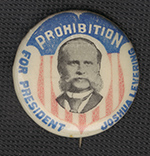 |
“Prohibition: Joshua Levering for President.” [1896] [zoom] |
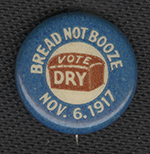 |
“Bread not booze: vote dry. Nov. 6, 1917.” [zoom] |
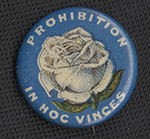 |
“Prohibition: In hoc vinces.” [zoom] |
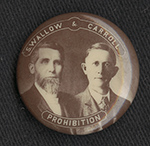 |
“Swallow & Carroll: Prohibition.” [1904] [zoom] |
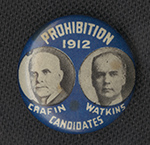 |
“Prohibition candidates 1912: Crafin & Watkins.” [zoom] |
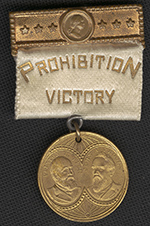 |
“Prohibition victory: Clinton B. Fisk & John A. Brooks.” [1888] [zoom] | Additional images: 
|
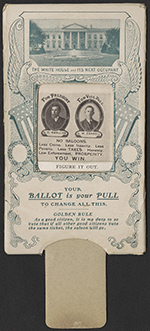 |
Prohibition Party. Campaign Card, ca. 1904. [zoom] | Additional images: 
By pulling down on the tab, a “good citizen” would be casting aside his vote for Theodore Roosevelt and Alton Parker in favor of the Prohibition Party candidates S.C. Swallow & G.W. Carroll. |
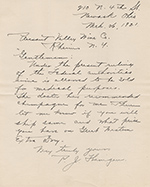 |
P.J. Flanigan. Letter to Pleasant Valley Wine Co., Rheims, N.Y. March 26, 1921. [zoom] After the Federal Government’s enactment of the 18th Amendment and the passing of the Volstead Act, people began looking for loopholes that would allow them to continue purchasing alcoholic beverages. Numerous loopholes emerged: doctors began prescribing alcohol for medicinal purposes, religious leaders requested elixirs for their flocks, and individuals brewed their own drinks at home. Here, Mr. Flanigan is writing to request Great Western Extra Dry Champagne, prescribed by his doctor. |
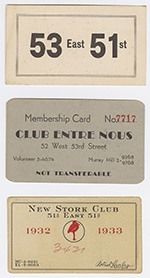 |
Membership Cards. Speakeasies, ca. 1921-1933. [zoom] | Additional images: 
Speakeasies were establishments created to service the underground, clandestine sale and consumption of alcohol during American Prohibition. Seemingly innocuous club membership cards often contained cryptic markings and numeric sequences, which permitted the bearer access to the premises. |
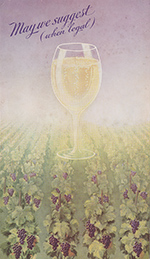 |
May We Suggest (When Legal). New York: Jos. Garneau Co. Importers, ca. 1921-1933. [zoom] |
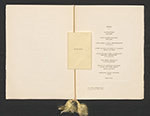 |
Dinner to James Woods Given By John McEntee Bowman. The Biltmore, May 8th, 1923. [zoom] | Additional images: 
Some restaurants discreetly signaled the availability of alcohol to trusted patrons by slipping an ‘Entre nous’ (Between ourselves) card inside menus. |
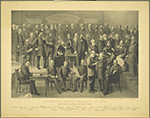 |
Prohibition Party Leaders of 1884, Engraving, ca. 1884. [zoom] |
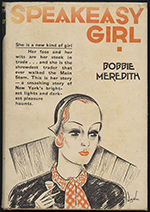 |
Bobbie Meredith. Speakeasy Girl. New York: Covici Friede, 1931. [zoom] This novel reflects societal influences, attitudes, and behavior during American Prohibition. For today’s reader, it permits a fascinating glimpse into the popular culture of the era. |